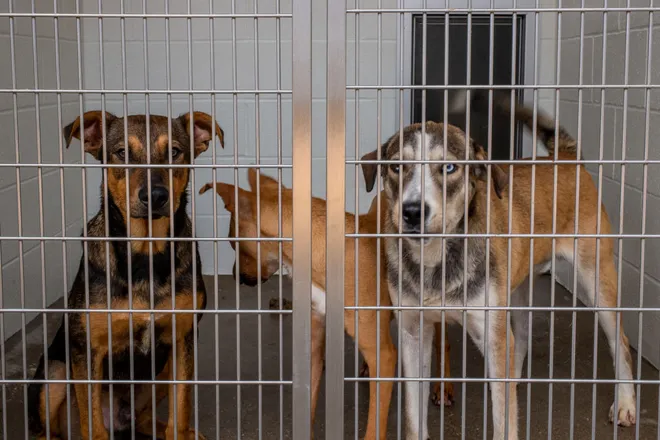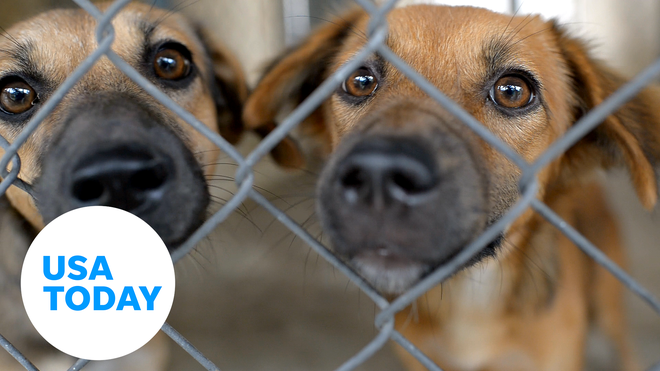How many dogs are euthanized in the US every year? In 2023, the number surpassed cats
Nearly a million more pets are crowding the nation’s animal shelters and facilities compared to three years ago, with more dogs than cats euthanized last year for the first time since one major animal advocacy organization began tracking those figures in 2016.
Shelter and rescue populations in the U.S. have surged by 900,000 overall since January 2021, and more than 359,000 dogs were euthanized in 2023, marking a five-year peak, according to animal advocacy group Shelter Animals Count. Meanwhile, 330,000 cats were euthanized last year.
“We are trying to empty a river of unwanted pets with a small bucket,” said Kelley Kimble, president of Briscoe Animal Resource Center in Uvalde, Texas.
The findings were announced in an annual analysis of shelter populations compiled by Shelter Animals Count, an Atlanta-based nonprofit founded in 2012 by a cross-section of animal welfare agencies.
“Everywhere you turn, the shelters are in crisis,” said Stephanie Filer, the group’s executive director. “It’s truly about an imbalance of animals coming in at faster rates than they’re leaving.”

For years, Filer said, cats were considered most at risk, entering shelters at high rates while facing low numbers of adoptions. But the last two decades have seen focused efforts by advocates to reverse both trends, with promising results.
“We have seen major positive change,” Filer said. “Adoption rates are high and intakes have decreased, and there are efforts to keep cats at home or in their communities.”
Meanwhile, she said, dog programs are suffering, with adoptions over the last four years running lower than 2018 and 2019 – and barely at 2016-2017 levels.
“Too many dogs are entering shelters and being left behind,” she said. “Unlike cat adoptions, which continue to increase, dog adoptions have essentially flatlined.”
As a result, shelters are teeming not only with the kinds of dogs that people might imagine, like large-breed mutts and pit bulls; but also huskies, French bulldogs and designer dogs.
Still, that dogs would overtake cats in facing euthanization was not something advocates saw coming.
“The real reason we’re saying, ‘Wow,’ is that it wasn’t that way for a lot of years,” Filer said. “And now it is.”
Economic challenges for owners, staff shortages for shelters
More than 6.5 million animals entered U.S. shelters and rescues in 2023, marking the fourth consecutive year of overpopulation and adoption rates insufficient to meet the challenge. Consequently, other animals are being turned away.
“We have seen steady increases in animal intakes, flatlines or decreases in outcomes, and a persistent gap in animals awaiting an outcome,” the Shelter Animals Count report reads. “The result? An ongoing capacity crisis.”

While 4.8 million cats and dogs were adopted out in 2023, adoptions aren’t keeping pace with animal intake as economic factors such as job loss, inflation and housing costs challenge owners considering a pet or trying to keep one.
"With more animals entering shelters than leaving, animal welfare organizations and their communities need to continue working together to keep pets in loving homes and out of shelters, including finding ways to increase access to veterinary care and advocating for pet-friendly housing policies," said Matt Bershadker, president and CEO of the American Society for the Prevention of Cruelty to Animals.
Additionally, staff and veterinarian shortages hamper shelters’ ability to confront the challenges of animals with greater medical and behavioral needs. In a 2022 ASPCA national survey, more than two thirds of shelters and rescues cited their inability to manage the frequency and severity of animal behavior and medical issues as a top barrier to placement.
ASPCA spokesman Alexander Craig said the organization actively advocates for more equitable access to increasingly scarce pet-friendly housing and is working to provide owners with subsidized veterinary care and resources, with focused efforts in New York, Los Angeles and Miami.
Effects of pandemic linger for shelters
Studies indicate just a quarter of dogs are adopted from shelters, Filer said; meanwhile, an estimated 23 million households acquired pets during the pandemic.
“If you figure about a quarter of those dogs were acquired from animal shelters, that’s a lot acquired from other sources,” she said. “So we know there is a demand for pets. One way to reverse this trend is to shift that acquisition over to shelters, and even a small shift would make a big difference.”

Among the factors driving the population boom, advocates say, are lingering repercussions of suspended spay and neuter efforts during the pandemic as many states halted nonessential surgeries.
“Shelters are still feeling the effects,” said Taylor Spreitler of the Nashville Humane Association.
In January, Spreitler said, the shelter took in more than 150 puppies, “which is very rare to see in winter months. Until spay and neuter resources are more accessible, we will continue to face overcrowding.”
The situation is even more dire for the Humane Society of Utah, where animal care manager Jeannie Lambert urged people to stop supporting at-home breeders, noting the shelter receives at least one litter weekly of intentionally bred puppies that have gone unsold.
She said 528 puppies were surrendered to the shelter in 2023, a 20% spike over the previous year. This year, meanwhile, is on pace to exceed that number, with 120 puppies surrendered in just the first six weeks of 2024 and 50 more scheduled for admission by month’s end.
The agency is a private shelter and not required to take in strays, which allows its population to remain within capacity. At the same time, however, it’s unable to support other shelters by assisting with overflow, Lambert said.

The agency has found some success with its Last Litter program, which offers free spays, vaccines and microchips for mother dogs whose guardians surrender their litters for adoption. Last year, 645 animals were surrendered to the shelter through the program, including 441 kittens and 59 puppies.
But when owners decline the offer to have their dog spayed, she said, that’s an indicator “that they’re most likely planning to breed the mom. We see that relatively often.”
How you can help overcrowded pet shelters
Filer, of Shelter Animals Count, said efforts need to focus on promotion of shelter adoptions.
“Rescuing your pet from a sheltering organization need to be something of a pride point, something to brag about,” she said. “And encouraging your friends and family to do the same. That’s the number-one call to action.”
Doing so, she said, “not only saves lives but sends a much-needed message of support to struggling shelters and their staff. Adopting a pet is also the most sustainable and socially conscious choice, which helps alleviate the shelter crisis rather than compounding it.”
While adopting a pet isn’t possible for everyone, Filer said, there are other ways to help – by fostering pets, or by volunteering at or donating to local shelters.

Those looking to adopt a pet can find a wide variety on sites such as Petfinder, Adopt A Pet or Best Friends Animal Society – from dogs and cats to rabbits and guinea pigs. Websites offer potential owners the ability to be specific about what they’re seeking, and even to be alerted when the right animal comes in.
“Adoptions are keeping up with technology to make it easier,” she said.
Additionally, pet owners can help by ensuring their pets are spayed or neutered and outfitted with identifying collars and/or microchips to aid reunification of lost animals with their owners.
“Shelters need help now more than ever,” Filer said. “This is a community problem that requires a community solution.”
Disclaimer: The copyright of this article belongs to the original author. Reposting this article is solely for the purpose of information dissemination and does not constitute any investment advice. If there is any infringement, please contact us immediately. We will make corrections or deletions as necessary. Thank you.





